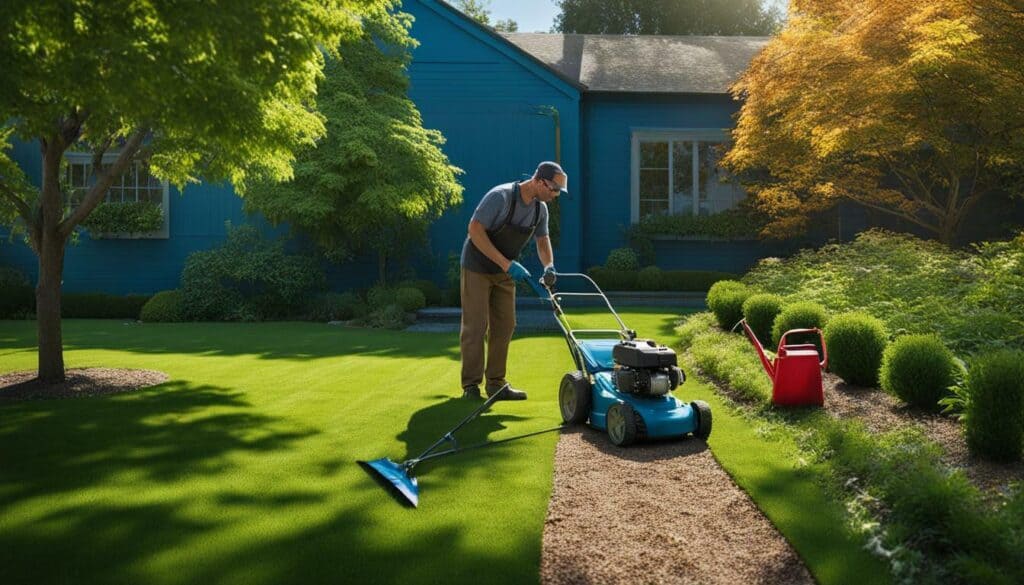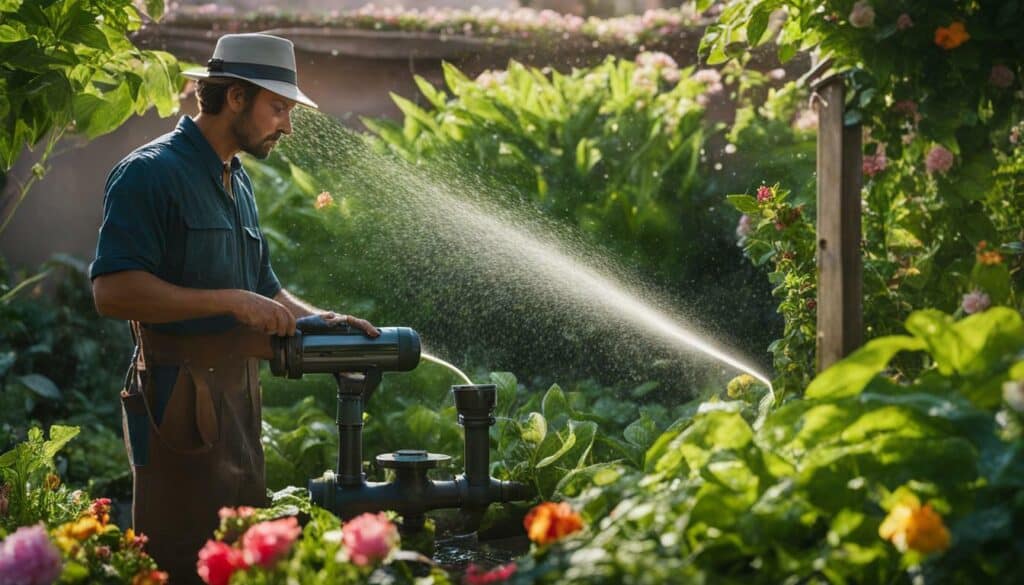Are you ready to dive into the world of garden and lawn care and create the yard of your dreams? Look no further – this comprehensive guide has everything you need! From organic gardening tips to landscape design techniques, lawn maintenance essentials to effective weed control methods, this guide will equip you with the knowledge and expertise to transform your outdoor space into a lush and beautiful oasis.
- Organic gardening is gaining popularity due to its eco-friendly practices and healthier produce.
- A well-designed landscape can enhance the beauty of your garden and increase curb appeal.
- Regular lawn maintenance is essential for achieving a vibrant and lush green carpet of grass.
- Effective weed control methods, both chemical and natural, can help you keep your garden weed-free.
- Proper lawn mowing techniques can make a significant difference in the health and appearance of your grass.
With these key takeaways in mind, you’ll be well on your way to mastering the art of garden and lawn care. So, let’s get started and turn your yard into a haven of natural beauty!
Top Tips for Organic Gardening
Discover the secrets of organic gardening and learn how to grow a thriving garden without the use of synthetic pesticides or fertilizers. Organic gardening is not only better for the environment but also ensures that you’re producing healthier and more nutritious fruits, vegetables, and flowers.
To start your organic garden, it’s important to prepare the soil properly. Use compost or organic matter to enrich the soil with essential nutrients. This will help promote healthy plant growth and improve soil structure, leading to better moisture retention.
When it comes to pest control, natural alternatives are key. Instead of relying on chemical pesticides, try using beneficial insects like ladybugs and praying mantises to control pests. You can also make homemade organic sprays using ingredients like garlic, neem oil, or soap to ward off common garden pests.
In addition to pest control, organic gardening emphasizes the use of organic fertilizers. Look for natural alternatives such as compost tea, fish emulsion, or seaweed extract to provide your plants with the necessary nutrients. These organic fertilizers release nutrients slowly, ensuring long-lasting and sustainable plant growth.
- Prepare the soil with compost or organic matter.
- Use natural pest control methods like beneficial insects and organic sprays.
- Choose organic fertilizers for sustainable plant growth.

Organic gardening isn’t just limited to flowers. You can also grow your own fresh and delicious vegetables! When planning your vegetable garden layout, consider the sun exposure, soil quality, and water availability for each type of vegetable.
| Vegetable | Sun Exposure | Soil pH | Watering Needs |
|---|---|---|---|
| Tomatoes | Full sun | 6.0-7.0 | Regular watering |
| Carrots | Partial shade | 5.5-7.0 | Consistent moisture |
| Lettuce | Partial shade | 6.0-7.0 | Regular watering |
By understanding the specific needs of each vegetable and grouping them accordingly, you can create a vegetable garden that maximizes space and productivity. Remember to rotate your crops each year to prevent the buildup of diseases and pests.
“Organic gardening is a holistic approach that nurtures the soil, plants, and ecosystem as a whole.”
So, whether you’re planting colorful flowers or growing your own food, organic gardening is a rewarding and sustainable choice. Embrace the natural methods of pest control, soil enrichment, and proper watering to create a thriving garden that’s in harmony with nature.
Creating a Beautiful Landscape Design
Transform your outdoor space into a stunning landscape with these expert tips and design ideas. A well-designed landscape not only enhances the beauty of your garden but also creates a harmonious and inviting atmosphere. Whether you have a small backyard or a sprawling estate, careful planning and attention to detail can help you create a visually pleasing outdoor oasis.
“A beautifully designed landscape is like a work of art, with each element carefully chosen and arranged to create a harmonious composition.”
– Expert Landscape Designer
Before diving into the design process, it’s important to consider the overall theme or style you want to achieve. Are you looking for a formal, symmetrical garden with clean lines and traditional elements? Or perhaps a more relaxed and naturalistic design with curved pathways and native plantings? Identifying your preferred style will guide your design choices and ensure a cohesive look throughout your landscape.
Once you have a clear vision in mind, it’s time to consider the key elements of landscape design. These elements include:
- Plant Selection: Choose a variety of plants that thrive in your climate and complement your desired aesthetic. Consider factors such as color, texture, and seasonal interest.
- Hardscaping: Incorporate elements such as pathways, patios, and walls to add structure and functionality to your landscape.
- Water Features: A soothing fountain or a tranquil pond can add a sense of serenity to your outdoor space.
- Outdoor Lighting: Strategically placed lighting can highlight key features and create a magical ambiance in the evening hours.
Remember to take into account the scale and proportion of your landscape. Balance large and small plants, create focal points, and ensure there is a sense of unity and flow throughout your design. Don’t be afraid to experiment and get creative; landscaping is an art form, and your garden is your canvas!
| Plant | Sunlight Requirements | Height |
|---|---|---|
| Roses | Full Sun | 2-6 feet |
| Lavender | Full Sun | 1-3 feet |
| Hostas | Partial Shade | 1-4 feet |
| Japanese Maple | Partial Shade | 6-25 feet |
Remember, designing your landscape is an ongoing process. As your plants grow and evolve, you may need to make adjustments to maintain the desired look and functionality. With patience, creativity, and a bit of experimentation, you can create a beautiful landscape that reflects your personal style and brings joy to your outdoor living space.

Maintaining a beautiful lawn doesn’t have to be a chore – follow these essential tips to keep your grass looking healthy and vibrant year-round.
1. Start with Proper Soil Preparation:
Before planting grass seed, it’s crucial to prepare the soil properly. Remove any rocks, debris, or weeds from the area and till the soil to loosen it. Adding organic matter like compost or peat moss can improve soil structure and fertility.
2. Water Deeply and Infrequently:
To encourage deep root growth, it’s important to water your lawn deeply and infrequently. Give your grass a good soaking, ensuring the water reaches about 6 inches into the soil. Watering early in the morning or late in the evening reduces evaporation and helps the water penetrate the roots.
3. Regularly Mow at the Right Height:
Set your lawnmower blades to the appropriate height for your grass type. Mowing too short can stress your lawn and make it more susceptible to weeds. As a general rule, aim to remove no more than one-third of the grass height in a single mowing.
4. Aerating for Better Nutrient Absorption:
Aerating your lawn helps improve air and water circulation in the soil, promoting better nutrient absorption by the grass roots. Use a core aerator or hire a professional to perforate small holes in your lawn, allowing for enhanced oxygenation and reduced soil compaction.
| Task | Frequency |
|---|---|
| Fertilize | 2-4 times per year |
| Weed Control | As needed |
| Overseed | Once a year |
| Dethatch | As needed |
Every lawn is unique, so it’s important to adjust your maintenance routine based on your specific grass type, climate, and other factors. Regularly monitor your lawn’s health and make adjustments as necessary to ensure optimal care.

Soil testing is an essential component of lawn maintenance. It provides valuable information about your soil’s pH levels, nutrient content, and organic matter. By conducting a soil test, you can identify any deficiencies or imbalances and make informed decisions about the types and amounts of fertilizers or amendments your lawn needs.
By following these essential lawn maintenance tips, you’ll be well on your way to achieving a lush and healthy lawn that will be the envy of the neighborhood. Remember to stay consistent with your lawn care routine and adjust it as needed to address any specific issues that arise.
Effective Weed Control Methods
Say goodbye to unwanted weeds with these effective methods that will keep your garden looking pristine and weed-free. Weeds can quickly invade your garden and compete with your plants for essential nutrients, water, and sunlight. To maintain a healthy and beautiful garden, it’s crucial to implement effective weed control strategies. Here are some proven methods to help you tackle those pesky weeds:
Natural Weed Control
Natural weed control methods are safe for the environment and can be just as effective as chemical treatments. One popular natural remedy is mulching. By applying a layer of organic mulch, such as wood chips or straw, around your plants, you create a barrier that blocks weed growth. Mulch also helps retain moisture in the soil and regulate soil temperature.
Another natural method is hand-pulling weeds. This method requires some effort but can be highly effective, especially for small weed patches. Make sure to pull the entire weed, including the roots, to prevent regrowth. Use a garden tool, like a trowel or weed puller, to make the task easier.
Chemical Weed Control
If natural methods alone are not sufficient, you may consider using chemical weed control products. Herbicides containing glyphosate are commonly used to kill weeds effectively. However, it’s important to follow the instructions carefully and use these products responsibly to minimize harm to other plants and the environment. Always wear protective clothing and avoid spraying on windy days to prevent drift.
| Pros of Chemical Weed Control | Cons of Chemical Weed Control |
|---|---|
| – Effective at killing weeds | – Potential harm to other plants |
| – Time-saving | – Environmental concerns |
| – Wide range of products available | – Health risks if not used properly |
Remember, it’s essential to choose the right herbicide for your specific weed problem and follow the instructions provided by the manufacturer. Always prioritize the safety of your plants, yourself, and the environment when using chemical weed control methods.
By implementing these effective weed control methods, you can ensure a weed-free garden that allows your plants to thrive. Whether you prefer natural or chemical solutions, it’s important to stay consistent with weed prevention and removal to maintain the health and beauty of your garden.
Learn the secrets to perfect lawn mowing and achieve a beautifully manicured lawn with these expert techniques. Proper mowing not only enhances the appearance of your lawn but also promotes healthy grass growth. Here are some key tips to help you master the art of lawn mowing:
- Choose the right mower: Selecting the correct mower for your lawn size and type of grass is essential. For smaller yards, a push reel mower can be a great eco-friendly option, while larger areas may require a gas or electric-powered rotary mower.
- Adjust the cutting height: Setting the cutting height of your mower to the appropriate level is crucial. As a general rule, never cut more than one-third of the grass blade’s height at a time. Cutting too low can stress the grass and make it more susceptible to disease and weed infestation.
- Vary your mowing pattern: Avoid mowing in the same direction every time. Alternating your mowing pattern helps prevent soil compaction and ensures even grass growth. Consider mowing in diagonal or crisscross patterns to give your lawn a professional striped appearance.
- Keep your blades sharp: Dull mower blades tear the grass instead of cleanly cutting it, leading to brown edges and increased vulnerability to pests and diseases. Regularly sharpen your blades or replace them when necessary to maintain a clean and healthy cut.
- Leave the clippings: Grass clippings contain valuable nutrients that can nourish your lawn. Unless you’re dealing with excessive thatch buildup, consider leaving the clippings on the grass as they decompose quickly and provide natural fertilizer.
To visualize the proper lawn mowing techniques, refer to the table below:
| Mowing Technique | Description |
|---|---|
| Regular Mowing | Mow your lawn at regular intervals to maintain an even height throughout the season. Aim to mow when the grass is dry to avoid clumping. |
| Alternate Mowing Patterns | Vary your mowing pattern each time you mow to prevent soil compaction and encourage healthy grass growth. |
| Sharp Blades | Ensure your mower blades are sharp to achieve clean cuts that promote optimal grass health. |
| Proper Cutting Height | Set your mower to the correct cutting height for your grass type and adjust as needed throughout the season. |
| Leave the Clippings | Leave grass clippings on the lawn to provide natural fertilization and retain moisture. |
By following these lawn mowing techniques, you’ll be well on your way to maintaining a healthy and vibrant lawn that will be the envy of the neighborhood.

Keep your garden hydrated and thriving with these efficient irrigation methods that ensure your plants receive the perfect amount of water. Proper watering is essential for the health and growth of your plants, and using the right irrigation techniques can help you achieve optimal results.
One of the most effective methods of garden irrigation is drip irrigation. This technique involves placing small hoses or tubes near the base of your plants, allowing water to gradually drip directly onto the soil. Drip irrigation not only conserves water by minimizing evaporation, but it also prevents water wastage by delivering moisture exactly where it’s needed. It’s especially beneficial for plants that prefer well-drained soil or those susceptible to fungal diseases.
An alternative method is the use of soaker hoses. These porous hoses release water slowly and evenly along their entire length, providing thorough irrigation for your garden beds. Soaker hoses are easy to install and can be placed on the soil surface or buried slightly to minimize tripping hazards. They are ideal for both flower and vegetable gardens, as they promote deep root growth while keeping the foliage dry, reducing the risk of fungal infections.
For larger garden areas, consider installing a sprinkler system. Automatic sprinkler systems can be tailored to specific watering needs, allowing you to adjust the coverage and duration of irrigation. This method is ideal for lawns and expansive gardens, providing even and consistent watering across the entire area. However, it’s essential to monitor your sprinkler system and ensure it doesn’t lead to overwatering or wastage.
Table: Pros and Cons of Different Garden Irrigation Methods
| Method | Pros | Cons |
|---|---|---|
| Drip Irrigation |
|
|
| Soaker Hoses |
|
|
| Sprinkler System |
|
|
When choosing the right irrigation method for your garden, consider factors such as your plant’s water requirements, soil type, and garden size. It’s essential to strike the right balance between providing enough water for healthy plant growth while avoiding water wastage. Regularly monitor your plants’ moisture levels and adjust your irrigation schedule as needed. With these efficient garden irrigation methods, you can ensure your plants receive the care they need to thrive.

Nurturing Healthy Plants with Proper Care
Discover the secrets to nurturing healthy plants through proper care techniques, ensuring they flourish and bring beauty to your garden. Providing adequate care to your plants is essential for their growth, resilience, and overall well-being. Here are some key practices to help you maintain healthy plants:
1. Soil Preparation
Good soil is the foundation for healthy plants. Start by testing your soil to determine its pH level and nutrient content. Based on the results, you can amend the soil with organic matter, such as compost, to improve its structure and fertility. Remember to provide appropriate drainage for your plants by ensuring the soil is well-drained or adding organic material like peat moss.
2. Watering and Irrigation
Watering your plants properly is crucial. Different plants have different water requirements, so it’s important to understand the specific needs of each species. Always water at the root level to minimize evaporation and avoid wetting the foliage excessively, as this can lead to disease. Consider using efficient irrigation methods, like drip irrigation or soaker hoses, to conserve water and deliver it directly to the plant’s root zone.
3. Pest and Disease Control
Keep an eye out for pests and diseases that can harm your plants. Regularly inspect your garden for signs of infestation or infection, such as wilting leaves, holes, or discoloration. Employ natural pest control methods first, such as introducing beneficial insects or using organic pest repellents. If the problem persists, consider using targeted pesticides as a last resort, but always follow the instructions carefully.

| Plant Type | Light Requirements | Watering Needs | Special Care |
|---|---|---|---|
| Rose | Full sun | Regular watering | Prune in early spring |
| Fern | Indirect sunlight | Keep soil moist | Mist leaves regularly |
| Succulent | Bright light | Sparse watering | Avoid overwatering |
| Tomato | Full sun | Regular watering | Support with stakes or cages |
Remember, each plant has its own unique needs, so it’s important to research and understand the specific care requirements for the plants in your garden. By providing proper care, you’ll create an environment where your plants can thrive, bringing beauty and joy to your outdoor space.
Choosing the Right Lawn Treatments
Get your lawn on the right track with these tips for choosing the right treatments to address its specific needs and keep it vibrant and free of pests. When it comes to maintaining a healthy and beautiful lawn, selecting the appropriate lawn treatments is crucial. From fertilizers to pest control products, making informed choices will ensure your lawn thrives in optimal conditions.
Soil testing: Before applying any treatments, it’s essential to test your soil to determine its pH level and nutrient content. This will help you identify any deficiencies and choose the right amendments. Soil testing kits are readily available at garden centers or you can send a soil sample to a professional laboratory for more accurate results.
Common Lawn Treatments
Fertilizers: Choose a fertilizer that matches your lawn’s needs. Nitrogen-rich fertilizers promote healthy growth and greening, while phosphorus and potassium contribute to root development and overall strength. Consider slow-release fertilizers for long-lasting results, and always follow the recommended application rates to prevent overfeeding and potential damage.
Weed control: Eliminating weeds is essential for maintaining a pristine lawn. Herbicides can be selective, targeting only specific types of weeds, or non-selective, killing all vegetation. Choose the appropriate herbicide based on the types of weeds you have and follow the instructions carefully to avoid harming desirable plants.
Pest control: Keep pests at bay with the right treatments. Insecticides target specific pests like grubs, ants, or aphids, while fungicides help control diseases like brown patch or powdery mildew. Consider organic options if you prefer eco-friendly alternatives, and always read and follow the instructions to ensure safe and effective application.
| Treatment | Purpose | Application |
|---|---|---|
| Fertilizers | Promote healthy growth and greening | Apply according to recommended rates |
| Weed control | Eliminate unwanted weeds | Follow instructions and target specific weeds |
| Pest control | Address insect or disease infestations | Use specific products and apply as directed |
By choosing the right lawn treatments and applying them correctly, you can ensure your lawn remains lush, vibrant, and free from pests. Remember to read product labels, follow instructions carefully, and prioritize the health and sustainability of your lawn. With these tips, your lawn will be the envy of the neighborhood!

Congratulations! You’ve now completed the ultimate garden and lawn care guide, and you’re ready to embark on your journey to a stunning and well-maintained yard. Throughout this guide, we have covered a wide range of topics to help you transform your outdoor space into a lush and beautiful oasis.
From organic gardening to landscape design, lawn maintenance to weed control, and plant care to proper irrigation methods, you now have the knowledge and tools to create a thriving garden and lawn. By following the tips and advice provided, you can achieve a vibrant and healthy outdoor space that will be the envy of your neighbors.
Remember, successful garden and lawn care starts with understanding the needs of your plants and the environment they thrive in. Take the time to assess your soil quality, choose the right treatments and fertilizers, and water your plants efficiently. By nurturing healthy plants, addressing weed and pest control, and maintaining proper lawn mowing techniques, you can enjoy a beautiful and well-maintained yard throughout the year.
So go ahead, put your newfound knowledge into action and create the garden and lawn of your dreams. Enjoy the therapeutic benefits of gardening, connect with nature, and take pride in your outdoor space. With the ultimate garden and lawn care guide by your side, you have all the tools and information you need for success. Happy gardening!
FAQ
Q: What topics does the Your Ultimate Garden and Lawn Care Guide cover?
A: The guide covers a wide range of topics including organic gardening, landscape design, lawn maintenance, weed control, lawn mowing techniques, garden irrigation, plant care, and choosing the right lawn treatments.
Q: Why is organic gardening gaining popularity?
A: Organic gardening is gaining popularity due to its eco-friendly practices and the production of healthier, chemical-free produce.
Q: How can I create a visually pleasing landscape design?
A: The guide offers insights into the elements of landscape design and provides tips on how to create a beautiful outdoor space.
Q: What are some essential lawn maintenance tips?
A: The guide shares essential lawn maintenance tips to help you achieve a vibrant and lush green carpet of grass.
Q: How can I effectively control weeds in my garden?
A: The guide explores effective weed control methods, both chemical and natural, to help you keep pesky weeds at bay.
Q: What are some expert tips for mastering lawn mowing techniques?
A: The guide shares expert tips on how to achieve a professionally manicured lawn through proper mowing techniques.
Q: How can I water my garden plants efficiently?
A: The guide discusses various garden irrigation methods and provides tips on how to water your plants effectively, conserving water in the process.
Q: What are some key aspects of plant care?
A: The guide delves into the key aspects of plant care, from soil preparation to pest control, ensuring your plants thrive in a healthy environment.
Q: How do I choose the right lawn treatments?
A: The guide guides you through the process of selecting the appropriate lawn treatments, including fertilizers and pest control products, to maintain a healthy and weed-free lawn.
What are the Best Practices for Garden and Lawn Maintenance?
When it comes to mastering garden and lawn maintenance, there are several best practices to follow. Firstly, regular watering is crucial to keep plants healthy and hydrated. Secondly, proper mowing techniques, like adjusting the cutting height, can prevent damage and promote healthy growth. Additionally, timely fertilization, weed control, and regular pruning contribute to a well-maintained garden and lawn. Lastly, staying observant for pest and disease issues allows for early detection and effective treatment, ensuring a thriving outdoor space.





Leave a Reply